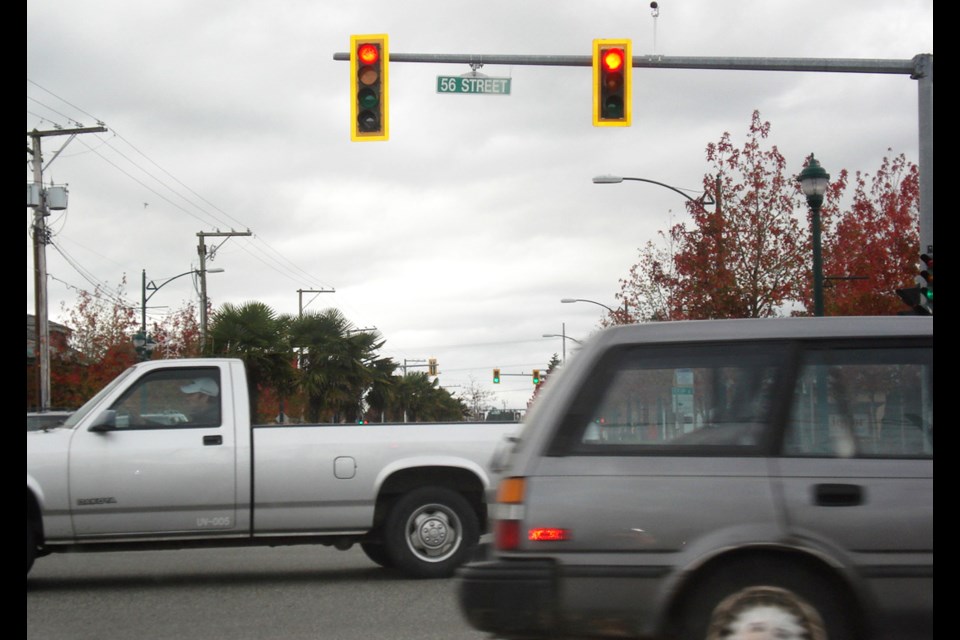The City of Delta could be implementing extensive measures to make a busy intersection at 56th Street and 12th Avenue in Tsawwassen a little safer for pedestrians.
Members of the Mobility and Accessibility Committee this summer discussed with engineering staff the city’s plan to create a Vision Zero Strategy, aimed at making roadways safer and reducing accidents and fatalities.
The city has already set aside funding to hire a consulting company to conduct community engagement to obtain feedback.
A current report was compiled by Binnie Consulting Ltd. and outlines the top 20 Delta crash sites, as well as potential countermeasures that could be implemented in the short, medium and long-term when it comes to intersections.
Of the top 20 highest crash locations in Delta, using ICBC and Delta Emergency Services collision data, the intersection at 56th Street and 12th Avenue ranked 17th on the list.
Committee members raised concern about the intersection, noting it could be beneficial to change the traffic signs at the location to indicate "no right turn on red."
Saying the city has already started making safety improvements at intersections, engineering staff pointed to details outlined in the current report that could be explored to further enhance safety.
The identified short-term measures include painted ladder crosswalk markings, which provide high visibility to approaching vehicles compared to standard parallel pavement markings. The markings also improve the yielding behavior to pedestrians, and is also known as a "zebra crosswalk marking."
Another potential short-term measure includes leading pedestrian interval (LPI), a modification to pedestrian signals within the traffic signal cycle, which typically gives pedestrians a four-to-six second head start than the same direction of traffic at the green signal.
The LPI increases the visibility of crossing pedestrians and allows them to have a higher priority within the intersection, the report notes, adding an LPI requires an adjustment to existing signal timing, which is a comparably lower cost than other countermeasures such as protected-only left turn phasing.
Medium-term possibilities include median refuge islands. These are a protected space placed in the median of a two-way street that allows pedestrians and cyclists to navigate only one direction of traffic at a time. It can enhance pedestrian safety and comfort.
Long-term ideas include single-lane roundabouts, which the report notes have been proven to reduce vehicle speed and eliminate specific collision types, such as left-turn collisions and head-on crashes.
A single-lane configuration can also lower the chance of side-swipes, however, care needs to be taken for roundabouts at high volume pedestrian and bicycle locations, the report notes. They can also be a potential issue for the visually impaired.
The report notes long-term countermeasures can be considered if short and medium-term countermeasures are not applicable.
The long-term countermeasures typically require a longer time and high expense to implement. They may also require additional road-of-way, which may require negotiations with property owners.
Among the other potential solutions is something being piloted called a centreline speedbump, which a rubber speed bump acting as an extension of a centreline into the intersection.
The report explains that they prevent motorists from making a high-speed left turn and encourage motorists to approach the crosswalk at a sharper angle.
This countermeasure can help reduce left-turn collisions and vehicle-pedestrian collisions as motorists would drive at a lower speed and can see pedestrians on a crosswalk with a better visibility.
It is a new safety countermeasure that has decreased 20 per cent of pedestrian-related collisions in New York City and is currently being piloted by the City of Toronto.
Another idea in the report is protected left-turn phases at intersections, which provide a separate phase for left-turning traffic. They allow left-turns to be made only on a green left arrow signal indication.
The report outlines several criteria that would warrant the implementation of such a measure.
Engineering staff also told the committee that, following conversations with community members who face accessibility challenges, the city is looking to make accessibility improvements to specific sites around Delta, including Ladner Trunk Road.
The project will commence in early fall of 2022 and some changes have already been implemented, such as increased crossing times for pedestrians at intersections.
The committee commented that it would be beneficial for city staff to tour the streets in wheelchairs or to wear glasses that obstruct their vision in order to gain a new perspective, and in an effort to find solutions to current accessibility issues.



